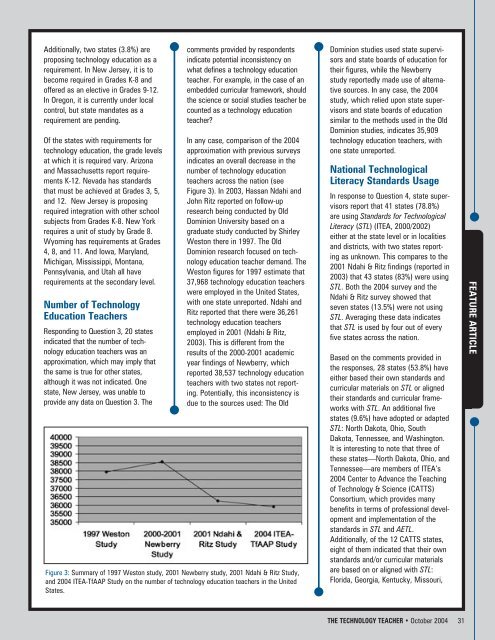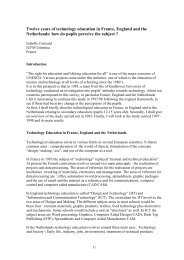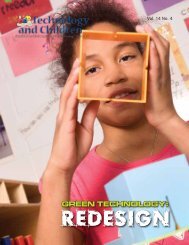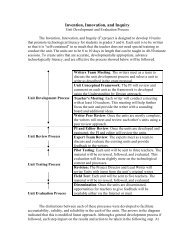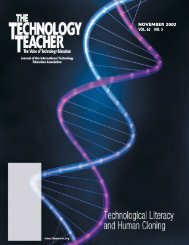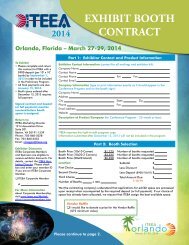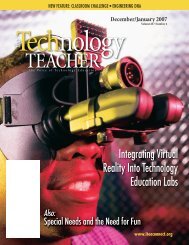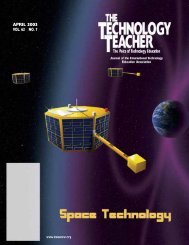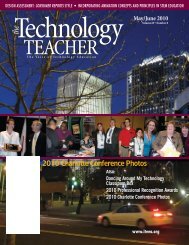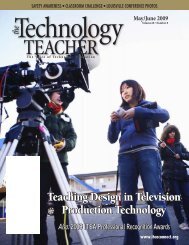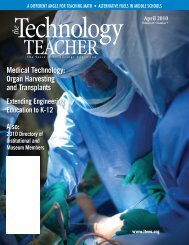October 2004 - Vol 64, No.2 - International Technology and ...
October 2004 - Vol 64, No.2 - International Technology and ...
October 2004 - Vol 64, No.2 - International Technology and ...
- No tags were found...
Create successful ePaper yourself
Turn your PDF publications into a flip-book with our unique Google optimized e-Paper software.
Additionally, two states (3.8%) areproposing technology education as arequirement. In New Jersey, it is tobecome required in Grades K-8 <strong>and</strong>offered as an elective in Grades 9-12.In Oregon, it is currently under localcontrol, but state m<strong>and</strong>ates as arequirement are pending.Of the states with requirements fortechnology education, the grade levelsat which it is required vary. Arizona<strong>and</strong> Massachusetts report requirementsK-12. Nevada has st<strong>and</strong>ardsthat must be achieved at Grades 3, 5,<strong>and</strong> 12. New Jersey is proposingrequired integration with other schoolsubjects from Grades K-8. New Yorkrequires a unit of study by Grade 8.Wyoming has requirements at Grades4, 8, <strong>and</strong> 11. And Iowa, Maryl<strong>and</strong>,Michigan, Mississippi, Montana,Pennsylvania, <strong>and</strong> Utah all haverequirements at the secondary level.Number of <strong>Technology</strong>Education TeachersResponding to Question 3, 20 statesindicated that the number of technologyeducation teachers was anapproximation, which may imply thatthe same is true for other states,although it was not indicated. Onestate, New Jersey, was unable toprovide any data on Question 3. Thecomments provided by respondentsindicate potential inconsistency onwhat defines a technology educationteacher. For example, in the case of anembedded curricular framework, shouldthe science or social studies teacher becounted as a technology educationteacher?In any case, comparison of the <strong>2004</strong>approximation with previous surveysindicates an overall decrease in thenumber of technology educationteachers across the nation (seeFigure 3). In 2003, Hassan Ndahi <strong>and</strong>John Ritz reported on follow-upresearch being conducted by OldDominion University based on agraduate study conducted by ShirleyWeston there in 1997. The OldDominion research focused on technologyeducation teacher dem<strong>and</strong>. TheWeston figures for 1997 estimate that37,968 technology education teacherswere employed in the United States,with one state unreported. Ndahi <strong>and</strong>Ritz reported that there were 36,261technology education teachersemployed in 2001 (Ndahi & Ritz,2003). This is different from theresults of the 2000-2001 academicyear findings of Newberry, whichreported 38,537 technology educationteachers with two states not reporting.Potentially, this inconsistency isdue to the sources used: The OldFigure 3: Summary of 1997 Weston study, 2001 Newberry study, 2001 Ndahi & Ritz Study,<strong>and</strong> <strong>2004</strong> ITEA-TfAAP Study on the number of technology education teachers in the UnitedStates.Dominion studies used state supervisors<strong>and</strong> state boards of education fortheir figures, while the Newberrystudy reportedly made use of alternativesources. In any case, the <strong>2004</strong>study, which relied upon state supervisors<strong>and</strong> state boards of educationsimilar to the methods used in the OldDominion studies, indicates 35,909technology education teachers, withone state unreported.National TechnologicalLiteracy St<strong>and</strong>ards UsageIn response to Question 4, state supervisorsreport that 41 states (78.8%)are using St<strong>and</strong>ards for TechnologicalLiteracy (STL) (ITEA, 2000/2002)either at the state level or in localities<strong>and</strong> districts, with two states reportingas unknown. This compares to the2001 Ndahi & Ritz findings (reported in2003) that 43 states (83%) were usingSTL. Both the <strong>2004</strong> survey <strong>and</strong> theNdahi & Ritz survey showed thatseven states (13.5%) were not usingSTL. Averaging these data indicatesthat STL is used by four out of everyfive states across the nation.Based on the comments provided inthe responses, 28 states (53.8%) haveeither based their own st<strong>and</strong>ards <strong>and</strong>curricular materials on STL or alignedtheir st<strong>and</strong>ards <strong>and</strong> curricular frameworkswith STL. An additional fivestates (9.6%) have adopted or adaptedSTL: North Dakota, Ohio, SouthDakota, Tennessee, <strong>and</strong> Washington.It is interesting to note that three ofthese states—North Dakota, Ohio, <strong>and</strong>Tennessee—are members of ITEA’s<strong>2004</strong> Center to Advance the Teachingof <strong>Technology</strong> & Science (CATTS)Consortium, which provides manybenefits in terms of professional development<strong>and</strong> implementation of thest<strong>and</strong>ards in STL <strong>and</strong> AETL.Additionally, of the 12 CATTS states,eight of them indicated that their ownst<strong>and</strong>ards <strong>and</strong>/or curricular materialsare based on or aligned with STL:Florida, Georgia, Kentucky, Missouri,FEATURE ARTICLETHE TECHNOLOGY TEACHER • <strong>October</strong> <strong>2004</strong> 31


